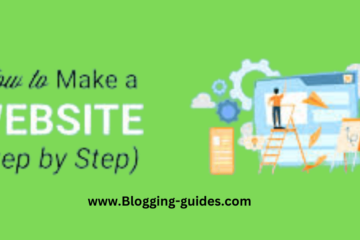Installing WordPress is easy but, right after installing it, you must do a series of actions in the installation of the web to ensure its proper functioning.
If you are reading this, it is because you have decided to install WordPress and I congratulate you, because there really is tremendous potential in this content manager, compared to other CMS that you can choose, especially for people and companies that really want to monitor what spend and profit from your website on the Internet.
The installation of WordPress is quite simple and safe as you may have already read the odd article on how to do it. It is no more than installing it in your web server account, whether it is shared or your own, and that’s it.
You can also use the quick installation, known as WordPress 1-click auto-install, which more and more WordPress hosting providers offer.
But I decided to create this list of 7 urgent things to do after installing WordPress, because I want you to start on the right foot in the adventure of your company on the Internet.
These are things that everyone who already has experience with WordPress knows and does automatically after installing this system, but that you, who may be just starting out in the WordPress world, can overlook.
Many of the things you have to do will be of the utmost importance, some others not so urgent, but believe me, the whole set is worth doing. Take it as a very useful check list.
- 15 things to do after installing WordPress for your website
- 1 .Check that your username and password are correct
- 2. Delete the Sample Content
- 3 . Set Title, Tagline and Timezone
- 4. Choose WWW or Non-WWW
- 5.Set up backups
- 6. Change your default theme
- 7. Change the permalinks
- 8. Add site icon and logo
- 9. Install the necessary WordPress plugins
- 10. Configure website information
- 11. Complete your user profile
- 12. Connect Your Site Google Analytics and Search Console
- 13. Add widget to sidebar
- 14. Add New Categories
- 15. Create Essential Pages
- Final touches after installing WordPress
15 things to do after installing WordPress for your website
Now let’s move on to those things you should do. The order is given according to how I do them every time I proceed to install WordPress for a web domain.
1 .Check that your username and password are correct
This is the first step when installing WordPress and it seems like the most obvious thing in the world, but it is very useful, believe me.
Checking that you have access to the control panel is important because it eliminates the doubt that you have placed something wrong, or that you have used the password that WordPress autogenerates and you have not copied it.
If when you click on “Access” you realize that you do not know the data to enter the control panel, do not despair; just go back and there you will be able to copy the password and the user.
Now, since we are talking about this, I recommend that you use your own password and not the WordPress one, more than anything because it is a very difficult password to remember. I’m not saying it’s not a good idea to have a strong password, but better use characters that you can remember.
Always remember to write down the password and if you have several websites, do not use the same password for all of them.
2. Delete the Sample Content
WordPress generates some sample content by default to help you understand things. You should remove them before you start building your site properly.
By default there are 4 types of content that you need to remove
1 .”Hello World” Post: To remove this sample post, you need to go to the WordPress dashboard such as go to Dashboard > Posts > All Posts and click on “Trash” under the Hello World post.
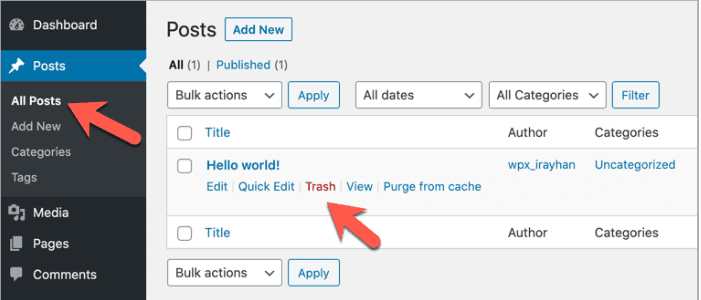
2.“Sample Page”: To delete the sample page, go to Pages; All Pages, select Sample Page and click “Detele”. and will be deleted.
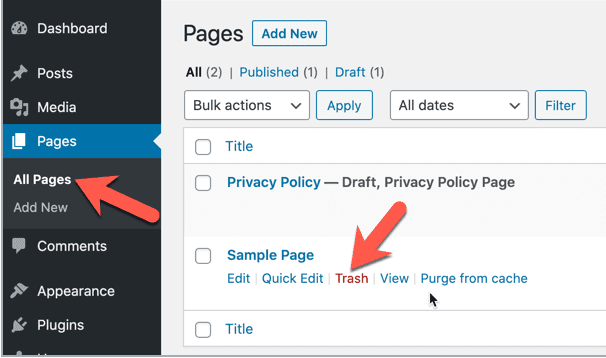
3.WordPress comment”: This comment will be automatically deleted after the “Hello World”post is deleted
4 .“Hello Dolly” Plugin WordPress also comes with a default plugin named “Hello Dolly”. This plugin is not required. Delete the plugin.
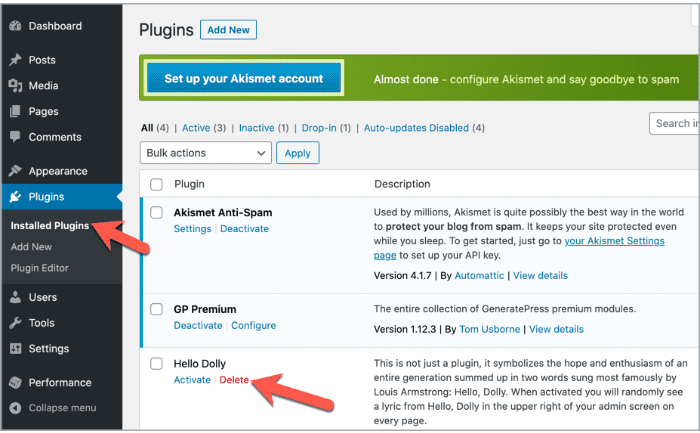
To delete a plugin, go to Plugins > Installed Plugins and click “Delete”.
3 . Set Title, Tagline and Timezone
Setting the website title, tagline and timezone is very easy. But most of the beginners neglect these things.
Website titles and taglines make it easy to understand what your site is about. Correct timezone is essential for scheduling your posts.
You can usually set all of these from the same page. for him
Go to Setting > General and enter your website title in place of your site title and tagline in place of tag line. If you are not sure what to write in the tagline, you can write it later. Then scroll down and choose a city in the same timezone as you.
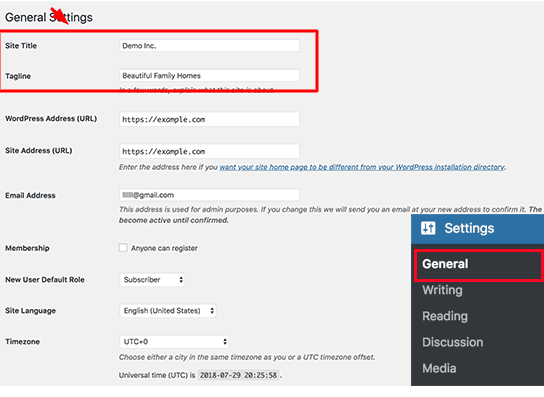
4. Choose WWW or Non-WWW
WordPress allows you to choose a WWW or non-WWW version of your site. You have to choose any one for your site. There is not much difference between the versions. But changing it later will cause problems
If you choose the non-WWW version, your blog URL will be http://yourdomain.com, and if you choose WWW, it will be http://www.yourdomain.com.
Search engines will treat both as two separate addresses. So frequent changes will create a lot of duplicate pages in Google index. This is very harmful for SEO.
Here at Blogging Guide, I am using the non-WWW version. By default, WordPress puts it as non-WWW. If you want to add WWW to your WordPress blog, go to Setting > General and add WWW to WordPress address and site address.
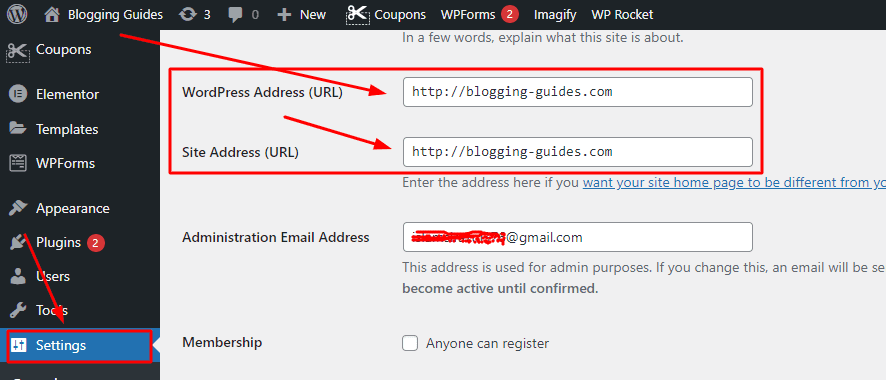
5.Set up backups
Regarding backups (backups) you have two options:
You verify that in the control panel of the web server, such as cPanel, the creation of daily backups or backups is configured, or
You install a plugin in WordPress that helps you create this copy of the site.
Personally, I prefer cPanel backups, mostly because they’re free and done automatically. There are also WordPress security plugins that perform backups automatically, but many times you have to pay for the full versions. We will talk about the paid versions of WordPress plugins and themes later.
Why is it so important to make backup copies of all the information on the website? Simple, because we never know when our website may stop working or be damaged for some reason and we need to recover that information. Remember that this web page is time and money invested that we do not want to lose for not having made a backup copy.
Speaking of security, it is key to update PHP on the web server, every time a new version appears because, apart from the significant improvements in speed and performance that this entails, it greatly strengthens the security of the web and the hosting server against all kinds of attacks.
6. Change your default theme
Once you have all your plugins installed, you have to install the WordPress theme, which will give the face to your website. In general, you can choose between two options: a free or paid WordPress theme.
I told you before that I was going to talk about this and I am a bit skeptical about buying WordPress themes.
The truth is that our experience, with paid themes, is not entirely good and that is because there are many paid themes that have too many functionalities (plugins) that require adaptation, can cause problems with each other and make the web go a lot. slower, as I mentioned before, and that search engines can penalize.
If you do not have experience with WordPress, I would tell you to install free or official WordPress themes and get familiar with the configuration. There is sure to be a free theme that gives you everything you want for your website.
In the same way, I tell you that many themes are free and have a paid version that you can activate once you try it; perhaps that is the most correct way to proceed when installing WordPress.
Of course, if you are trying different themes for your web page, remember to delete all the themes that you are no longer going to use, more than anything to save space and make the web page faster and more agile.
WordPress has a huge collection of free and premium themes. When you are just starting out you can start with a free theme But if you want to invest some money, go for a premium theme.
Here are some popular WordPress themes-
- Astra
- Generate Press
- Divi Theme
- Oceanwp
- Cadence
- Newspaper
You can learn more about WordPress themes here.
Once you find the right theme for your WordPress site, check out – How to Install a WordPress Theme.
7. Change the permalinks
Permalinks (permalinks) are the web addresses (URLs) that are generated every time you create a new blog post or page.
In the case of posts, WordPress gives you the freedom to choose how they look. You have options that can include the publication date and others that only include the hyphenated title.
At the level of SEO optimization for web positioning, it is preferred that the permalinks include only the name of the post, but WordPress brings the permalink by default with the inclusion of the date.
Changing it is very simple and you must do it so that the web addresses (URL) look the way you want them and, especially, to optimize the SEO of your Blog.
8. Add site icon and logo
A site icon is a small icon that appears on most browser tabs and bookmarks
And a logo is the small design that represents your site on the web. Having a unique favicon and logo is crucial to increase your brand awareness.
You can create a site icon using Photoshop or other tools. If you don’t have designing skills, you can use online tools like Favicon.cc or X-Icon Editor.
When it comes to designing a logo, you can do it yourself using Photoshop or online logo maker tools. Otherwise, you need to hire someone to create a logo for you.
You can hire a designer from Fiverr for as little as $5. If you want to invest more money, you can hire a professional designer from 99 Designs.
Once you’ve prepared the favicon and logo, go to WordPress Dashboard > Appearance > Customize.
Then click on ‘Site Identity’.
Then upload logo and site icon.
Just click ‘Publish’ and you’re done.
9. Install the necessary WordPress plugins
Now that we have checked that we have access to the control panel and that we have ensured that our website is automatically backed up, we will move on to creating the content of it. In this case we are going to talk about the configuration of the plugins necessary for WordPress to work as expected, but I must make a clarification before getting into the matter.
The selection and installation of WordPress plugins for your website will depend on what you want to achieve, but I do not recommend excessive use of plugins because it slows down the loading of the web page. Also, some are incompatible with some versions of WordPress and can cause problems; It has happened to all of us at some point.
For example, once a client asked me to install a plugin to remove and prevent comments from Blog articles. While that is a solution, it is not the most efficient. So we opted for a simpler solution: if I don’t want anyone to comment, then I go to the theme editor and remove the comment template calls from the code. Also, in WordPress, for that case, there are menus where you can disable those options.
As well as the plugin to avoid comments, there are many that are not necessary, since the same can be achieved by editing the code and it is more efficient. We must evaluate alternative options before installing a plugin.
plugins for security
Among the plugins that I think are essential, are the WordPress security ones, all those that lead to guaranteeing that our website is safe from web server problems and attacks from hackers, malware, and WordPress viruses.
In that sense, there are plugins to add a person verification in administrator access (anti-robot verification), to plugins that are responsible for scanning the website for threats.
It is important to clarify at this point that it is not just about installing, but it is also important to configure these plugins.
Install SEO plugin
The good thing about WordPress is that it has plugins that make SEO optimization tasks easier and you can easily achieve a good Google Pagespeed rating with your WordPress. One of the best known is Yoast SEO, which is a very complete SEO plugin, even in its free version.
With Yoast SEO, in addition to changing the information on each page, you can generate WordPress Sitemaps, something that is essential for good indexing in web search engines. Additionally, you can configure and link your Google Search Console account (formerly Google webmaster Tools) and from there see how the indexing of your web page evolves.
The truth is that I recommend this plugin for the SEO of your page and, although there are others, this one is easy to use, free and quite intuitive to use.
Plugins for web caching
This is one of the many cases where it is exemplified that the use of a plugin can be expendable. This is because, if you have access to the server account files, you can easily set the caching rules for your website via the .htaccess file, and that would be the most efficient solution.
Now, if you don’t know how to do it or you are a beginner in all this, you can install your caching plugin by the WordPress administrator.
I remind you quickly that you have to declare limits for the cache so that your web page runs faster and achieves better web positioning to search engines, such as Google.
If you ask me for a WordPress caching plugin name, I’d say W3 Total Cache, but mostly because it’s the only one we’ve used: we like to work from the .htaccess file in the web server panel.
Plugins to block spam
Every web page is susceptible to Spam and that is why you need to protect yourself against messages and spam, especially in the comments section of the Blog.
It is also true that spam can send you messages thanks to the contact page, but that is less annoying.
WordPress web design and development companies know that it is a headache to see all those comments that do not contribute anything. Above all, you must understand that Spam aims to link your website to other websites and, if it is not detected and avoided, it can be detrimental to your reputation with search engines such as Google.
Imagine that your web page is linking to a harmful website and your audience is directed to these sites only because you have not installed an anti-Spam plugin; a disaster for them and for your SEO because, as soon as Google detects it, it will penalize you.
Contact 7 Plugin
Every website on the Internet needs a contact form. This allows your website visitors to quickly contact you by filling out a form on your website.By default, WordPress does not come with an integrated contact form.
This is where Contact7 comes in.It is the best WordPress contact form plugin and lets you easily create beautiful contact forms for your website.
They have a Contact 7 free version that you can download from the WordPress.org plugin repository.
Check out our step-by-step guide on how to create a contact form on a WordPress website.
Other functional plugins
I wanted to include this section because I want to remind you that in WordPress there are plugins for everything and therefore you can customize your website the way you want.
I would recommend that you install a plugin to comply with the policies and regulations on the use of cookies as well as the RGPD law and legal notice.
You also have plugins for contact sheets and news subscription forms that are not bad at all and save a lot of time.
10. Configure website information
We are going to assume that you have the Yoast SEO plugin installed and, with this being the case, setting up the website information is very simple. With this plugin you can put the name you want to your web page and a personalized description.
It is very important that you make these changes because that information is what Google and other search engines use to index and position your web content.
When you change the name through Yoast SEO, the name of the page, as such, does not change, so you are free to put whatever you want in this description.
11. Complete your user profile
This is a trivial step if you like, but it’s a good thing to do. When you create your WordPress user, all you have is your email address and login name. In the settings panel you can add a longer description, your name, a profile picture and social networks.
All of this is reflected when you publish a new post, so it may be convenient to do so.
12. Connect Your Site Google Analytics and Search Console
Integrate your site with Google Analytics and search consoles like Google, Bing, Yahoo etc
Google Analytics and Search Console are must-have tools for site owners. Google Analytics tracks your visitors and Search Console helps you monitor your site’s performance in Google search. Both are free.
You need to connect your site with Google Analytics and Search Console to track your site performance.
How to Set Up Google Analytics in WordPress
How to Create a Sitemap in WordPress
How to Submit Sitemap to Google Search Console
13. Add widget to sidebar
Almost all WordPress themes have a widget-ready sidebar. It is usually placed on the right or left side of the webpage. You can add social media widget, recent post widget, popular widget post, affiliate disclaimer, newsletter form, Facebook like box widget etc. to your sidebar.
WordPress Every theme has some default widgets. And most premium WordPress themes add additional widgets to your WordPress site.
To add a widget to your sidebar, go to WordPress Dashboard > Appearance > Widgets. Then drag a widget (the one you want to add) from “Available Widgets” to “Sidebar”. Click on the widget and configure the widget settings.
14. Add New Categories
While you can add a new category while writing a post, it is recommended to add all categories before publishing the post. This will help you plan your posts properly.
To add categories to your website, go to WordPress Dashboard > Posts > Categories. Then write your category name, slug (URL) and description. And click on “Add New Category”.
15. Create Essential Pages
Like every website, a WordPress site needs some essential pages. You should create these pages before publishing the post. These pages vary from niche to niche.
Here are three important pages you should create immediately.
About
Contact
Privacy Policy
Final touches after installing WordPress
The favicon is the symbol that appears in the navigation tabs and that, in general, is the logo of your company. Changing the favicon what it does is that you personalize your web page. It’s silly, but it’s good that you do it for a matter of company image.
Other changes you need to make to make your site look good is to remove anything that comes pre-loaded with WordPress. WordPress usually presents you with an example page and an example post, just to show you what it looks like in the manager.
It is necessary that you delete that, more than anything for a matter of aesthetics and indexing. If you don’t delete the generic post, it will be indexed as part of your site.
As you may have seen, after installing WordPress there is a lot to do, but nothing so complicated that you get scared. I have always said that WordPress makes things a lot easier and in this case, except for the installation of the theme, you can have everything ready in a couple of hours at most.


